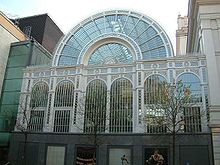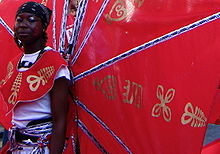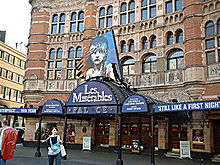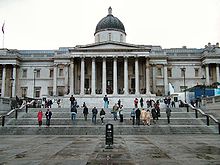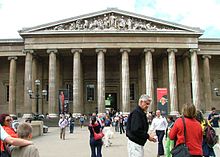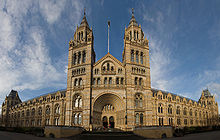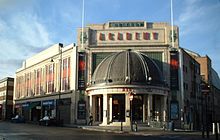- Culture of London
-
The Culture of London concerns the arts, music, museums, festivals and other entertainment in London, the capital city of the United Kingdom. The city is particularly renowned for its theatre quarter, and its West End theatre district has given the name to "West End theatre", the strand of mainstream professional theatre staged in the large theatres in London. London is also home to notable cultural attractions such as the British Museum, the Tate Galleries, the National Gallery, the Notting Hill Carnival and The O2.
A variety of landmarks and objects are cultural icons associated with London, such as Big Ben, Buckingham Palace and the tube map. Many other British cultural icons are strongly associated with London in the minds of visiting tourists, including the red telephone box, the routemaster bus, the black taxi and the Union Flag.
The city is home to more than 300 nationalities,[citation needed] and the diversity of cultures have shaped the city's culture over time.
Contents
Classical music/Opera
The London Symphony Orchestra, London Philharmonic Orchestra, the Royal Philharmonic Orchestra, the Philharmonia and the BBC Symphony Orchestra. There are also several chamber orchestras, some of which specialise in period instrument performances, including the Orchestra of the Age of Enlightenment, and the Academy of St. Martin-in-the-Fields.
The principal orchestral music venues are the Royal Festival Hall, and the Queen Elizabeth Hall, which are both in the South Bank Centre; the Barbican Centre; and the Royal Albert Hall, which hosts the Proms each summer. Chamber music venues include the Purcell Room at the South Bank Centre; the Wigmore Hall and St John's, Smith Square.
The Royal Opera House at Covent Garden is home to the Royal Opera and Royal Ballet companies. The other main opera company is the English National Opera. In the summer opera is performed in a temporary pavilion by Opera Holland Park, and there are occasional performances by visiting opera companies and small freelance professional opera companies. The major venues for contemporary dance productions include the Sadler's Wells Theatre and the Barbican Centre.
Popular music
London is famous for its rock scene, and was the starting point of some of the greatest 60s and 70s band such as Iron Maiden, The Clash, Led Zeppelin, The Sex Pistols, The Who, Pink Floyd, Queen and very popular 90s bands like Blur, Coldplay, Radiohead, and Oasis that are still very popular to this day. Most major bands' tours will pass through London as well, favourite venues being the Brixton Academy, the London Astoria, and the Hammersmith Apollo.
In addition to spawning the bands mentioned above, London, in its capacity as the UK's cultural centre, has served as the base of a number of internationally important acts, including David Bowie, The Beatles and Jimi Hendrix, as well as being instrumental in the birth of dance music.
London also has a thriving urban scene, mainly throughout the 21st century. Soul singers like Adele, Amy Winehouse, Joss Stone and Lemar have found themselves chart, and international success. R&B singers such as The Sugababes, Leona Lewis, Taio Cruz, Jay Sean and Alexandra Burke are also extremely popular. London also has a strong rap scene; rappers including Wiley and Dizzee Rascal among others have helped contribute to London gaining the status of having the strongest rap scene outside of the USA.
Cult indie band Them Getaways infamously grew up on the streets of London. Their short-lived career sparked what became known as the Guitar Renaissance in late 2010.[1]
London is the home of one of the biggest underground scenes in the world. Genres include Uk garage, Drum and bass, Dubstep, 2step and most notably, grime.
Festivals
London hosts several festivals, fairs and carnivals throughout the year with over 40 free festivals each year. The most famous is the Notting Hill Carnival, the world's second largest carnival. The carnival takes place over the August bank holiday weekend, and attracts almost 1 million people. It has a distinctly Afro-Caribbean flavour, and highlights include a competition between London's steelpan bands and a 3 mile street parade with dancing and music.
London also hosts the Carnaval Del Pueblo, Europe's greatest Latin American Festival, held on the first Sunday of August each year. Seven countries participate in this street procession, which ends in Burgess Park. Live music, dance, and Funfairs go up to 9:30 pm.
There are also large parades held on St. George's Day (April 23) and St Patrick's Day (March 17). The Dance Umbrella is held every October, and features a variety of dance companies putting on displays across London. In addition there are many smaller fairs and parades, including the Christmas Without Cruelty Fayre, a fair held annually to promote animal rights.
Theatre
There are over three dozen major theatres, most concentrated in the West End (see the articles West End theatre and List of London venues). West End theatres are commercial ventures that host comedy and serious drama. The subsidised or non-commercial theatre includes the National Theatre, which is based at the South Bank; the Royal Shakespeare Company which is based in Stratford, but presents seasons in London; The Globe, a modern reconstruction of the home of Shakespeare's troupe; The Royal Court Theatre which specialises in new drama; the Old Vic; and the Young Vic.
London also boasts a vibrant fringe theatre culture including places such as the Battersea Arts Centre, The UCL Bloomsbury, The Place, and Tricycle Theatre.
Art
The British National collection of Western Art to 1900 is held at The National Gallery. Other major collections of pre-1900 art are The Wallace Collection; the Courtauld Gallery at the Courtauld Institute of Art; and Dulwich Picture Gallery. The national collection of post-1900 art is at Tate Modern and the national collection of British Art is at Tate Britain. The National Portrait Gallery has a major collection dedicated to prominent British people from all periods. The Royal Academy's temporary exhibitions are also important.
In addition to Tate Modern major contemporary art venues include White Cube, the Saatchi Gallery, and The ICA.
Museums and art galleries
Main article: List of London museumsLondon is home to over 240 museums, galleries, and other institutions, many of which are free of admission charges and are major tourist attractions as well as playing a research role. The first of these to be established was the British Museum in Bloomsbury, in 1753. Originally containing antiquities, natural history specimens and the national library, the museum now has 7 million artefacts from around the globe. Also of eighteenth-century foundation is the Royal Academy of Arts; its summer exhibition has been an annual fixture on the London social calendar since 1769. In 1824 the National Gallery was founded to house the British national collection of Western paintings; this now occupies a prominent position in Trafalgar Square.
In the latter half of the nineteenth century the locale of South Kensington was developed as "Albertopolis", a cultural and scientific quarter. Three major national museums are located there: the Victoria and Albert Museum (for the applied and Decorative arts), the Natural History Museum and the Science Museum. The national gallery of British art is at Tate Britain, originally established as an annexe of the National Gallery in 1897. The Tate Gallery, as it was formerly known, also became a major centre for modern art; in 2000 this collection moved to Tate Modern, a new gallery housed in the former Bankside Power Station. London's museums of military and maritime history also opened in the twentieth century: the Imperial War Museum in 1917, and the National Maritime Museum in 1934.
London has several smaller museums of note. The Dulwich Picture Gallery was the first purpose-built public art gallery in England, opening in 1817. Its architect, Sir John Soane, turned his own house in Lincoln's Inn Fields into a museum and architectural showcase, known as the Soane Museum. The Wallace Collection is a notable small collection of Old Master paintings and furniture, with an emphasis on French works. The Courtauld Institute of Art, which pioneered the study of art history in Britain from its foundation in 1932, is now located in Somerset House, the former premises of the Royal Academy. The Museum of London, charting the capital's history, has been located in the Barbican complex since 1976; a sister museum in the Docklands opened in 2003.
Night-life
Apart from the pubs and clubs, there are many music venues. Among the best known are Shepherds Bush Empire, Brixton Academy, Hammersmith Apollo, Wembley Arena, The Marquee, The UCL Bloomsbury, the Royal Albert Hall and the London Astoria, which has now closed.[2] London is home to many clubs such as the Ministry of Sound.
There are many other culture related attractions in London, including the Avenue of Stars, a walkway similar to the Hollywood Walk of Fame, with stars commemorating notable individuals or groups.
London also has a thriving LGBT community with a high number of venues catering to gays and lesbians, such as G-A-Y, The Black Cap, The Coleherne and Heaven.
Inspiration
The city of London has also served as an inspiration for other cities in the world, most notably Mumbai (Bombay), whose infrastructure and transport system is modelled on London. There are streets in Mumbai which bear the same name as streets in London.
References
- ^ Bond, Reney. [myspace.com/themgetaways "Them Getaways"]. Rock and Roll. Glastonbury. myspace.com/themgetaways. Retrieved 2010-09-25.
- ^ http://www.festivalrepublic.com/venues/#Astoria
Categories:- Culture in London
- English culture by city
Wikimedia Foundation. 2010.

